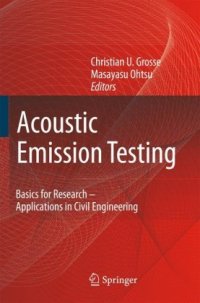
Ebook: Acoustic Emission Testing: Basics for Research - Applications in Civil Engineering
- Tags: Physics and Applied Physics in Engineering, Structural Materials, Quality Control Reliability Safety and Risk, Structural Mechanics, Acoustics, Building Repair and Maintenance
- Year: 2008
- Publisher: Springer-Verlag Berlin Heidelberg
- Edition: 1
- Language: English
- pdf
Acoustic Emission (AE) techniques have been studied in civil engineering for a long time. The techniques are recently going to be more and more applied to practical applications and to be standardized in the codes. This is because the increase of aging structures and disastrous damages due to recent earthquakes urgently demand for maintenance and retrofit of civil structures in service for example. It results in the need for the development of advanced and effective inspection techniques. Thus, AE techniques draw a great attention to diagnostic applications and in material testing. The book covers all levels from the description of AE basics for AE beginners (level of a student) to sophisticated AE algorithms and applications to real large-scale structures as well as the observation of the cracking process in laboratory specimen to study fracture processes.
Acoustic Emission (AE) techniques have been studied in civil engineering for a long time. The techniques are recently going to be more and more applied to practical applications and to be standardized in the codes. This is because the increase of aging structures and disastrous damages due to recent earthquakes urgently demand for maintenance and retrofit of civil structures in service for example. It results in the need for the development of advanced and effective inspection techniques. Thus, AE techniques draw a great attention to diagnostic applications and in material testing. The book covers all levels from the description of AE basics for AE beginners (level of a student) to sophisticated AE algorithms and applications to real large-scale structures as well as the observation of the cracking process in laboratory specimen to study fracture processes.